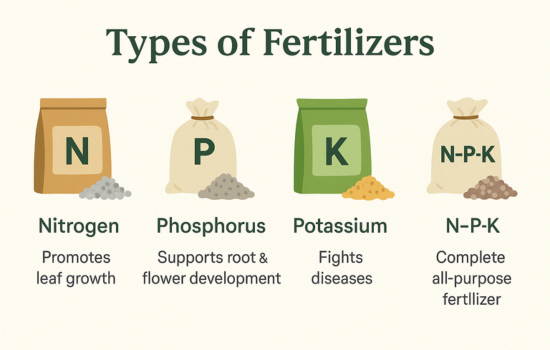When I started my home garden, I truly believed the secret to success was just sunlight, water, and love. But after a few weeks, I quickly realized that without proper nutrition, plants simply don’t thrive.
Some would grow a bit at first, but then stall, leaves would turn yellow, and all that energy would fade. That’s when I started to understand the importance of fertilizers — and more importantly, how to use them the right way.
If you’re in this early discovery phase or just getting your hands dirty with gardening — whether in soil, pots, or even hydroponics — I’m here to share exactly what I wish someone had explained to me back then.
These are 5 fertilizer tips for beginners to follow without fear — all tested, applied, and adjusted based on my own experience with urban gardens, apartment setups, and basic hydroponic systems.
Let’s learn together in a simple, practical, and confident way?

1. Understand the Basics: What Is NPK and Why It Matters
The first thing you need to do is stop being afraid of the letters. NPK isn’t some complicated chemical formula. It’s simply the combination of three essential nutrients your plants need for healthy growth:
- N for Nitrogen, which stimulates leaf and stem growth;
- P for Phosphorus, crucial for root development, flowering, and fruiting;
- K for Potassium, which strengthens plants and balances their overall health.
At the beginning, I thought all fertilizers were the same. I bought the cheapest bag on the shelf, applied it without reading anything… and instantly regretted it. Burned leaves, compacted soil, and plants that looked just plain sad.
What did I learn? Always read the label and understand what stage of plant development the fertilizer is intended for. If you’re growing lettuce, arugula, or spinach, for example, you’ll need a product with more nitrogen. For tomatoes or bell peppers, you’ll want something richer in phosphorus and potassium.
Start with this foundational knowledge. It will help you avoid the most common beginner mistakes — and set you up to use these 5 fertilizer tips for beginners with much more confidence.
2. Organic or Chemical Fertilizer? Here’s the Honest Truth
This is one of the most frequent questions I get: should I use organic or chemical fertilizer?
The most honest answer I can give you is: it depends on your goal, your schedule, and the type of garden you have. And yes — you can absolutely use both, just like I do in my own garden.
In soil or potted plants, I usually prefer organic fertilizers like worm castings, bone meal, castor cake, and even homemade compost. They work more slowly but improve the soil in the long run and add beneficial microorganisms.
In hydroponics, where plants don’t have access to soil, I use mineral-based, water-soluble fertilizers that deliver nutrients directly to the roots.
Here’s the important thing: neither one is the enemy. The secret is knowing when and how to use each one strategically. Over time, you’ll get a feel for when a plant needs a more powerful boost or when it’s better to stick with something softer and natural.
If I had to sum up this tip in a sentence, it would be: organic feeds the soil, chemical feeds the plant. Both are valuable.
3. Less Is More: How Not to Kill Your Plant With Good Intentions
There’s one mistake every beginner makes — thinking that more fertilizer means faster growth.
Yep, I’ve been there. And not just once. I got excited, doubled the recommended dose, and thought my plants would explode with growth. What actually happened? Leaf burn, nutrient lockout, salt buildup in the soil, and in some cases, dead plants.
The truth is that too much fertilizer can be just as harmful as too little. Plants get stressed, roots get damaged, and the soil turns into a lifeless crust.
So here’s my practical advice: always start with half the recommended dose listed on the package. Then observe. If your plant reacts well, you can gradually increase it. But if you see any signs of stress — like scorched edges, droopy leaves, or strange spots — stop immediately.
Plants don’t like being rushed. They grow at their own pace. Fertilizers are meant to support, not to force.
4. Liquid Fertilizers: The Secret to Quick Results (If Used Carefully)
Most people begin with solid or granular fertilizers — and that’s totally fine. They’re excellent for long-term nourishment. But liquid fertilizers are a powerful tool when applied at the right time.
They’re absorbed much faster and can give your plants a helpful “boost” when they’re recovering, trying to grow, or entering a flowering phase.
At home, I use liquid fertilizers on my greens right after transplanting. I also apply them when I notice that growth has stalled or the leaves are looking pale — classic signs of nutrient deficiency.
But here’s a key point: timing matters. Always apply in the late afternoon, after the sun has gone down. And never apply it undiluted — always follow the instructions on the label.
One more valuable tip: avoid wetting the leaves, especially on humid days. Apply directly to the soil, or into the nutrient solution if you’re growing hydroponically. It’s safer and way more effective.
5. Observation Is Everything: Record, Analyze, and Learn
If you truly want to level up as a grower, this is the tip that’ll take you from beginner to advanced: write everything down.
Seriously. It sounds simple, but hardly anyone does it.
I created a little garden notebook. In it, I write the date I fertilized, what type of fertilizer I used, which plant received it, and what happened in the days that followed.
Thanks to this habit, I now know that my green onions thrive with biweekly worm castings rather than weekly liquid feed. And that my basil loves a spoonful of castor cake every 20 days.
You don’t need to memorize everything. You just need to observe, experiment, and keep notes. That personal record will be your best teacher when it comes time to adjust doses, intervals, and combinations.
At the end of the day, plants communicate with us. We just have to learn how to listen.
Bonus Tip: Homemade Compost — Simple, Eco-Friendly, and Super Effective
Want a high-quality, organic fertilizer that’s totally free — and also helps the planet? Start composting at home.
With a small ventilated bucket, some leftover fruit and veggie scraps, and a little patience, you’ll turn garbage into life.
The finished compost is full of nutrients and beneficial microorganisms. It improves soil texture, boosts fertility, and makes your garden healthier with every use.
I use my compost in both my soil garden and to make a kind of “compost tea,” a liquid fertilizer I apply to more sensitive plants. It works beautifully.
Wrapping Up Like a True Grower
Growing a garden is more than just planting seeds and waiting. It’s a constant learning process. It’s about trial and error, paying attention, and connecting with nature.
These 5 fertilizer tips for beginners aren’t just about products or techniques. They’re about building intuition, developing a routine, and respecting the natural rhythm of plants.
With patience, care, and the right tools, you’ll start to see your plants respond — they’ll grow, bloom, and even feed you. And there’s nothing more satisfying than harvesting something you grew with your own hands.
Trust me: if I could learn all of this, so can you.
